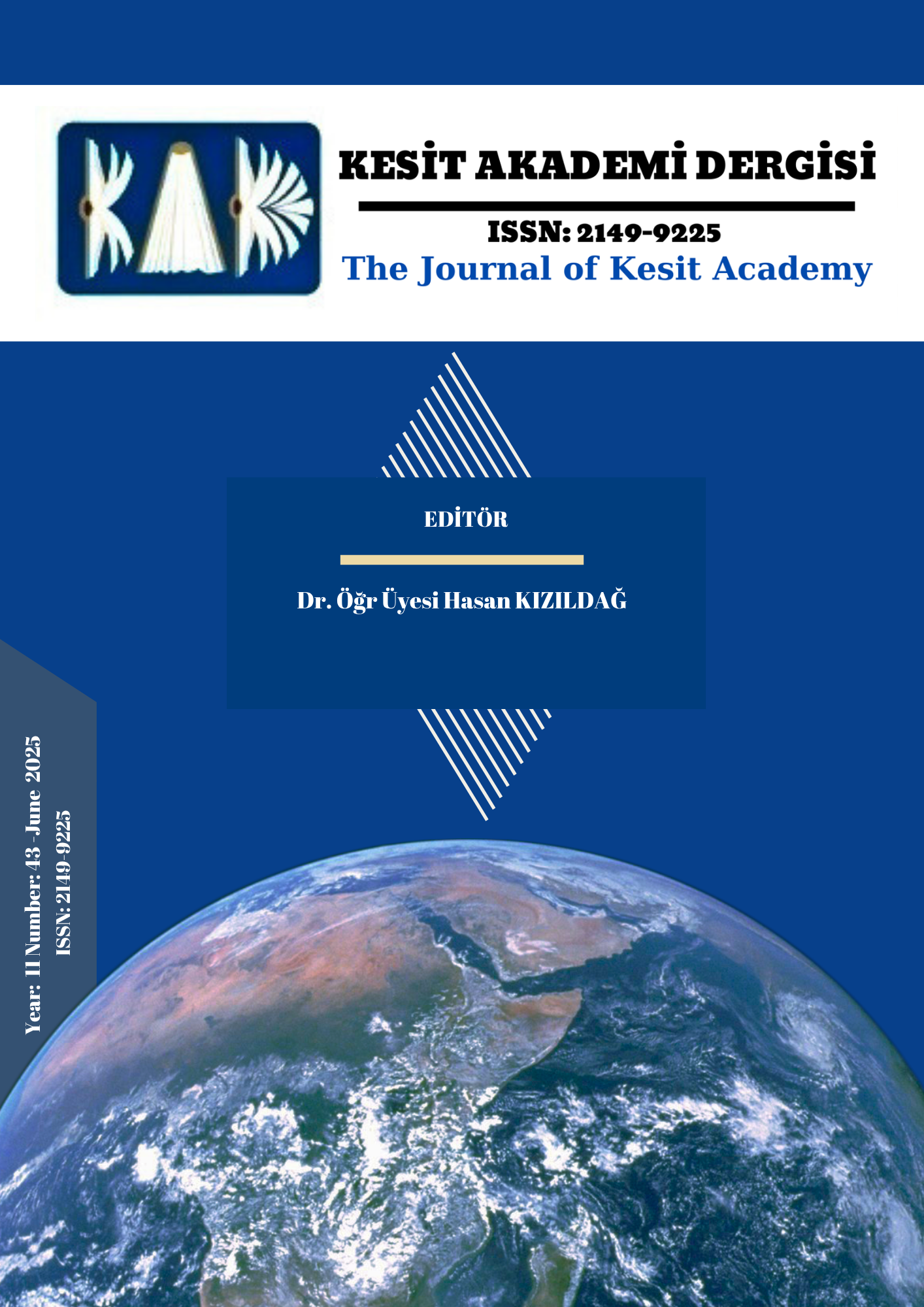Author :
Abstract
İnsanlık var olduğundan bu yana sanat her zaman en önemli ifade biçimlerinden biri olmuştur. Dünya tarihine baktığımızda sürekli yeni keşifler ve gelişmeler ışığında insanlar hem hayatını kolaylaştırmış hem de varoluşlarını devam ettirebilmişlerdir. Sanatçılar da gelişen yeni teknolojilere hemen entegre olmuş, yeni teknolojiler sayesinde üretimlerine farklı medyumlar ekleyerek kendilerini özgün biçimde anlatma yolu bulmuşlardır. Özellikle birinci endüstri devrimi ile hızla gelişen sanayi tipi üretim sayesinde sanatçılar atölyelerinden çıkarak tuvallerini istedikleri mekâna taşıyabilmiş ve daha özgür bir üretim şekli geliştirmişlerdir. Dijital teknolojilerin başlangıcı kabul edilen analog fotoğraf makinelerinin gelişmesi ile geleneksel sanat üretim teknikleri de sorgulanmaya başlanmış, sanatçılar dünyaya kendi gözlerinden bakmak yerine fotoğraf makinelerinin mercekleri ardında da bakmaya başlamışlardır. Böylelikle sanatsal medyumlara bir yenisi daha eklenmiştir. Günümüze yaklaştığımızda bilgisayarların gelişmesi ve her eve girmesiyle birlikte sanat üretimi artık dijitalleşme yolunda hız kazanmıştır. Sanatsal üretimler bilgisayar programlarıyla birlikte sayısal girdilere dönüşmüştür. Sanatsal üretimin değişen yönü izleyicinin de pozisyonunu değiştirmiştir. Önceden tuval karşısında duran izleyici artık ekran karşısında sanatsal üretimleri izleyebilmekte ve hatta etkileşime geçebilmektedir. Dijital üretimler ve bu üretimlere ilginin günden güne arttığı günümüzde sanatçılar için yeni bir üretim ve sergileme alanı olan sanal gerçeklik teknolojisi sanatçıya ve izleyiciye sağladığı ortam ve olanakların eşsizliği ile bu yeni teknolojiye olan talebi de günden güne arttırmaktadır. İlk ortaya çıktığı andan günümüze kadar sanatçının ve izleyicinin her zaman ilgisini çeken bu büyülü teknoloji, içinde barındırdığı benzersiz özellikler ile diğer sanatsal üretimlerden kendisini her zaman sıyırmayı başarmıştır. Sanatçıya yeni dünyalar yaratmak için sınırsız olanaklar sunan sanal gerçeklik teknolojisi sayesinde izleyicinin de gerçek dünya ile bağlantısı neredeyse tamamen koparak sanatçının zihnine “dalma” imkânı sağlanmıştır. Bu çalışmada sanatın dijitalleşme yolu izlenerek sanal gerçeklik teknolojisi ile kesiştirilmiş ve sanal gerçeklik teknolojisinin geçirdiği evrimler incelenerek günümüz çağdaş sanatı içinde sanal gerçeklik teknolojisinin kullanımı ve hala gelişmekte olan bu teknoloji ile son evrede neler yapılabileceği incelenmiştir. Ayrıca son gelişmeler ışığında sanal gerçeklik teknolojisinin geleceği hakkında öngörüler ve fikirler sunulmuştur. Bu çalışma, nitel araştırma yöntemleri kapsamında yer alan kavramsal içerik analizi ve literatür tarama tekniklerine dayanmaktadır. Araştırmanın temel amacı, sanal gerçeklik teknolojilerinin çağdaş sanat alanındaki yansımalarını, sanat izleyicisinin yeni pozisyonunu ve sanatçının zihinsel üretim süreçleriyle ilişkisini kuramsal bir çerçevede değerlendirmektir. Bu doğrultuda çalışma; hem sanal gerçekliğin tarihsel ve teknolojik gelişim sürecini hem de bu teknolojinin sanatçılar tarafından nasıl kullanıldığını incelemeyi amaçlamaktadır. Araştırmada seçilen sanatçılar ve eser örnekleri, sanatçının sanal gerçeklik teknolojisini sanatsal üretimlerine dahil etmesi ve sanal gerçeklik teknolojisinin ekipmanlarını sergileme süreçlerine dahil etmesi ölçütüne göre belirlenmiştir. Bu çalışma içinde yer alan sanatçılar hem dijital hem de fiziksel sanat üretim pratikleri ile sanal gerçeklik teknolojisinin sürrealist ya da simülasyon odaklı anlatılarla nasıl birleştiğini örnekleyen çalışmalara sahiptir. Bu sanatçıların üretimleri, araştırmanın tematik hedefleriyle örtüştüğü için örneklem olarak tercih edilmiştir.
Keywords
Abstract
Since the emergence of humankind, art has remained one of the most fundamental modes of expression. Throughout the course of world history, individuals have continuously adapted to new discoveries and innovations, which have not only facilitated daily life but also enabled the continuity of human existence. In parallel with these developments, artists have promptly embraced emerging technologies, integrating diverse media into their creative processes and discovering new, original methods of self-expression. Particularly following the First Industrial Revolution, the rapid growth of industrial production enabled artists to move beyond the confines of the studio, allowing them to transport their canvases to various environments and develop more liberated modes of production. The invention and advancement of analog cameras—often regarded as a precursor to digital technologies—initiated a critical reevaluation of traditional artistic techniques. Artists began to perceive and represent the world not solely through their own eyes but also through mechanical lenses, adding yet another dimension to the realm of artistic media. As the personal computer became more widespread, especially towards the late 20th century, the process of artistic production entered a new phase of digital transformation. Artistic outputs increasingly became data-driven, generated and manipulated through software. The traditional relationship between artwork and viewer also evolved: whereas audiences once encountered artworks on canvas, they now view—and in many cases interact with—them via screens. In contemporary times, where interest in digital production continues to grow rapidly, virtual reality (VR) technologies have emerged as a novel medium for both artistic creation and exhibition. The unique experiential environment provided by VR has significantly increased its appeal among artists and audiences alike. Since its inception, this captivating and immersive technology has consistently distinguished itself from other forms of artistic practice due to its unprecedented qualities. By offering artists an infinite array of possibilities to construct alternate worlds, VR has also enabled viewers to disconnect from the physical world and "immerse" themselves in the mental landscapes constructed by the artist. This study traces the digital transformation of art and its convergence with virtual reality technologies. It investigates the evolution of VR, its current applications in contemporary art practices, and explores potential future trajectories of this still-developing medium. In light of recent advancements, the study further presents theoretical reflections and foresight concerning the future of VR in artistic contexts. The research adopts a qualitative methodology, drawing on conceptual content analysis and literature review techniques. The primary aim is to examine the impact of VR technologies on contemporary art from a theoretical perspective, with particular attention to the shifting role of the viewer and the relationship between technological tools and the artist’s cognitive processes. Within this scope, the study explores both the historical-technological development of virtual reality and the various ways in which contemporary artists have utilized this technology in their creative practices. The selection of artists and artworks discussed in this study is based on the extent to which the artists have incorporated virtual reality both into their artistic production and exhibition processes. The featured artists exemplify how VR technologies intersect with surrealist or simulation-oriented narratives through a combination of digital and physical art-making practices. Their inclusion is grounded in the degree to which their works align with the thematic objectives of the research.





